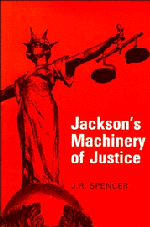Book contents
- Frontmatter
- Contents
- Acknowledgements
- List of figures
- List of tables
- Preface
- Preface to the first edition of ‘The Machinery of Justice in England’
- Abbreviations
- I Historical introduction
- II Civil jurisdiction
- III Tribunals
- IV Criminal jurisdiction
- 19 Courts with original criminal jurisdiction
- 20 Coroners' Courts
- 21 Courts with appellate criminal jurisdiction
- 22 The process of prosecution
- 23 Criminal procedure
- 24 The process of sentencing (including probation)
- 25 Juvenile courts
- 26 The matrimonial jurisdiction of magistrates – the Domestic Court
- V The personnel of the law
- VI The European dimension
- VII The cost of the law
- VIII Law Reform
- Appendix A The Report of the Civil Justice Review
- Table of Cases cited
- Table of Statutes cited
- Table of Stationery Office publications cited
- Index
24 - The process of sentencing (including probation)
Published online by Cambridge University Press: 10 January 2011
- Frontmatter
- Contents
- Acknowledgements
- List of figures
- List of tables
- Preface
- Preface to the first edition of ‘The Machinery of Justice in England’
- Abbreviations
- I Historical introduction
- II Civil jurisdiction
- III Tribunals
- IV Criminal jurisdiction
- 19 Courts with original criminal jurisdiction
- 20 Coroners' Courts
- 21 Courts with appellate criminal jurisdiction
- 22 The process of prosecution
- 23 Criminal procedure
- 24 The process of sentencing (including probation)
- 25 Juvenile courts
- 26 The matrimonial jurisdiction of magistrates – the Domestic Court
- V The personnel of the law
- VI The European dimension
- VII The cost of the law
- VIII Law Reform
- Appendix A The Report of the Civil Justice Review
- Table of Cases cited
- Table of Statutes cited
- Table of Stationery Office publications cited
- Index
Summary
The process of sentencing an offender must be sharply distinguished from the process of a trial. In the case of a trial on indictment, the verdict is that of a jury whilst the sentence is given by the judge. The distinction does not, of course, hold good for magistrates' courts; but whether the trial is on indictment or summary, there are certain principles that must be observed: there are strict rules of evidence, the burden of proof must be satisfied, and the issue to be decided must be clearly formulated. If the result of the trial is a conviction, or if the offender pleads guilty, the court must then decide whether a penalty is to be imposed, and if so, what it is to be. For every offence the law prescribes the penalties that may be imposed. Murder, and a few other offences, are exceptional in that there is only one penalty, so that the judge has no option and there can be no question of the amount of punishment. In most cases the law prescribes a maximum punishment, the court being free to impose a less amount. The court thus has a free hand within the limits laid down for the offence in question.
- Type
- Chapter
- Information
- Jackson's Machinery of Justice , pp. 272 - 304Publisher: Cambridge University PressPrint publication year: 1989

